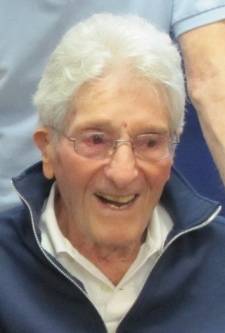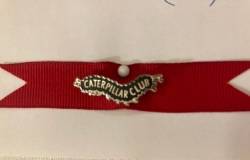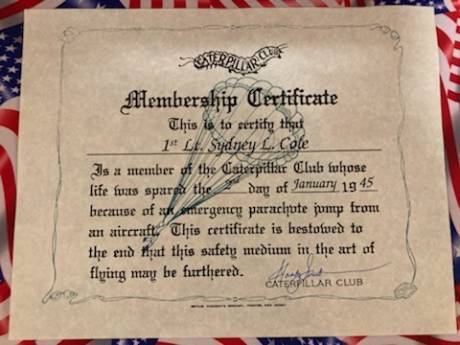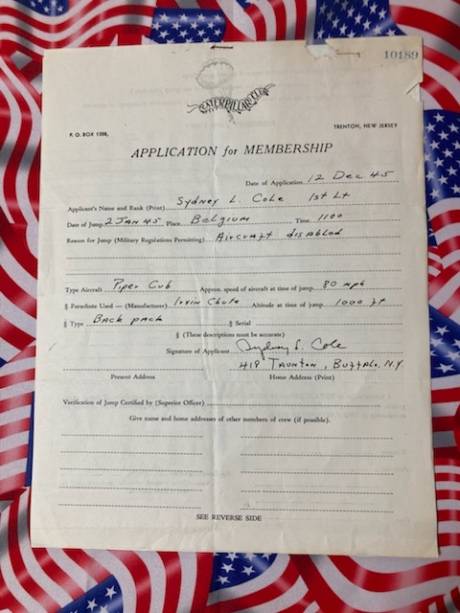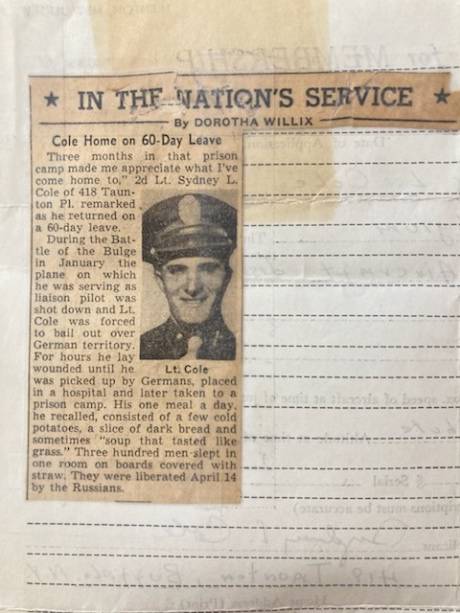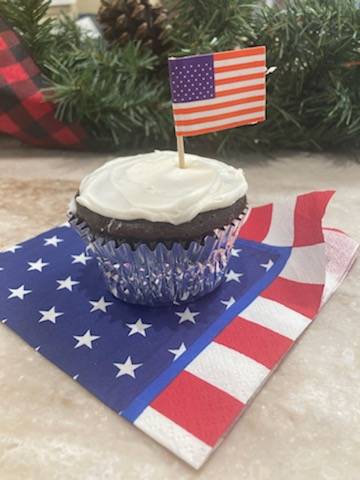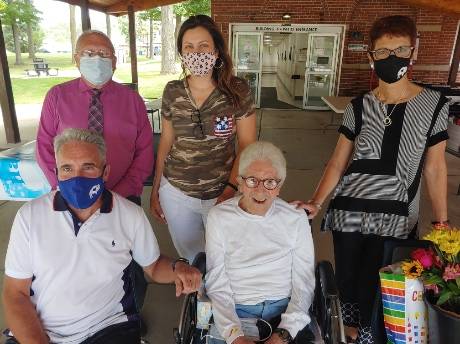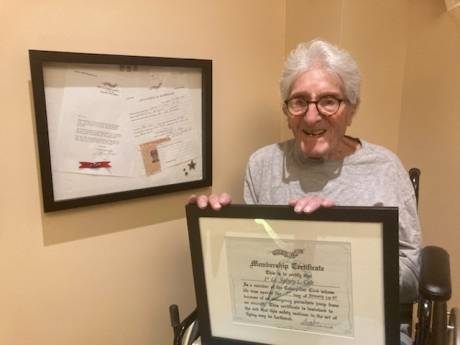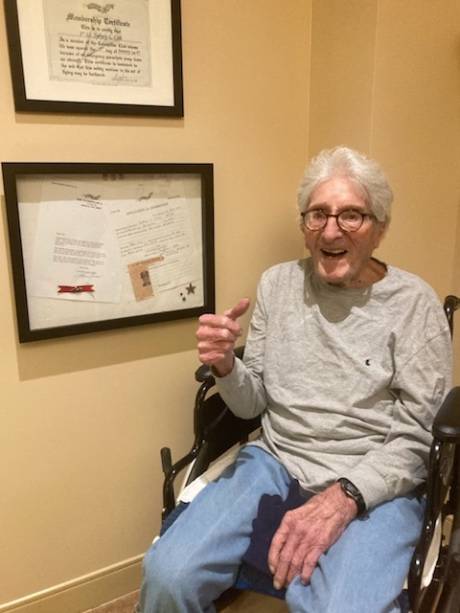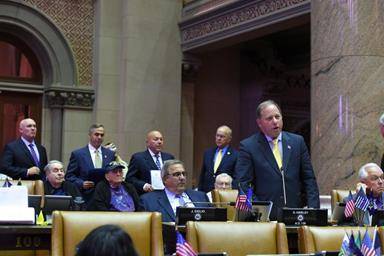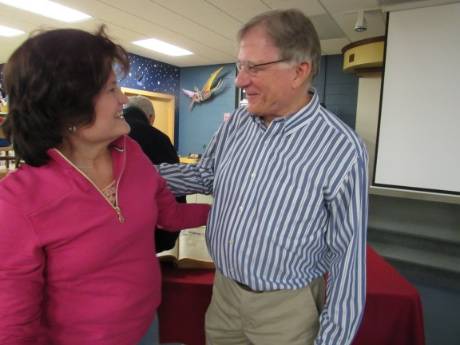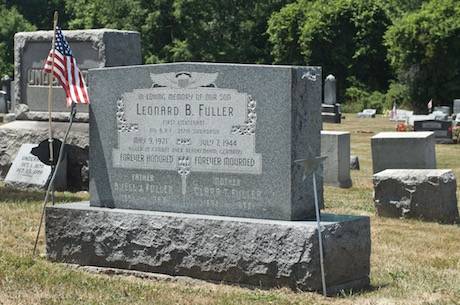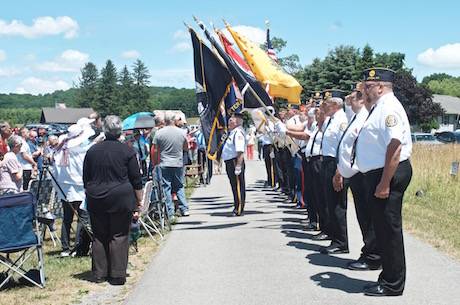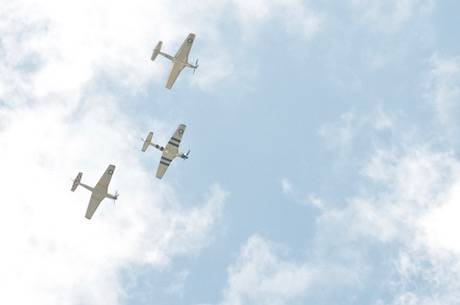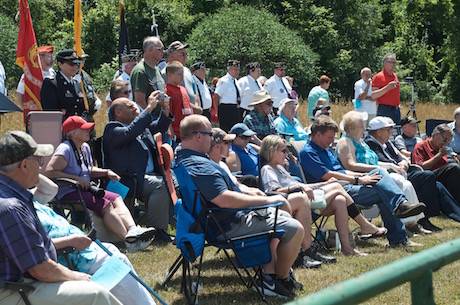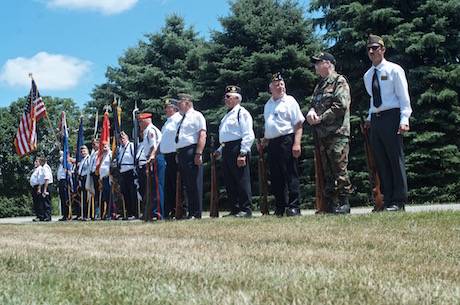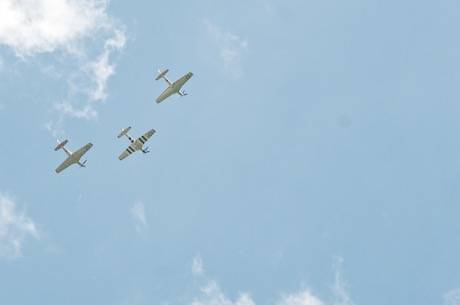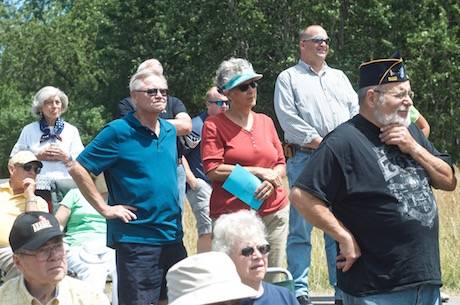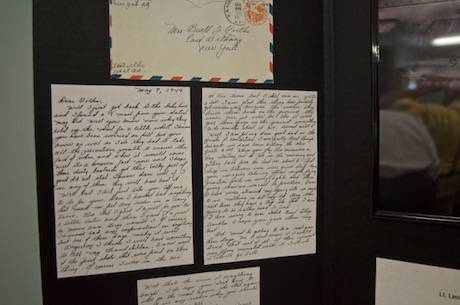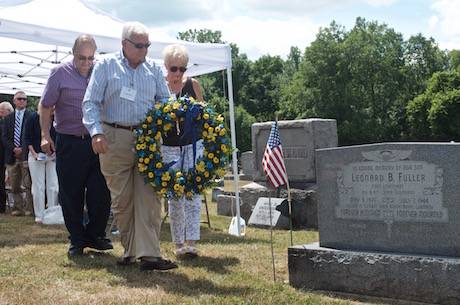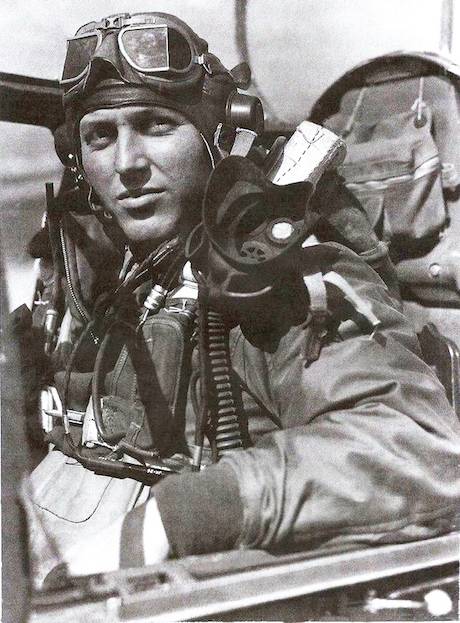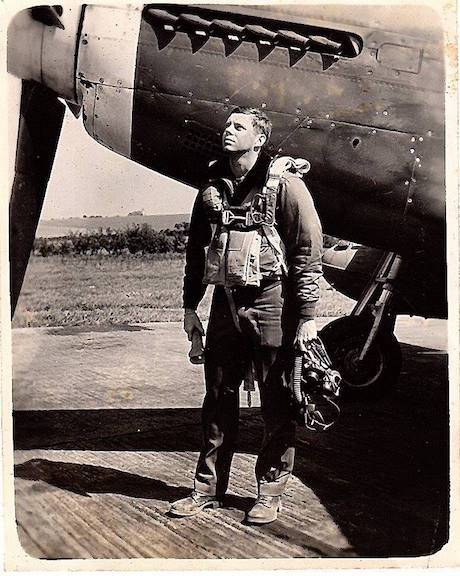On July 4, 1944, 1st Lt. Leonard B. Fuller had written in a letter home:
Well anyway, as I set here looking at these pictures it sure brings back some swell memories of all the hell raising and work I have done around home there. The picture of Doug by the garage there is o.k.! I sure would like to have my picture taken in that same spot.
It was evident in Leonard Fuller’s letters that he was very homesick, as he wrote about it often. His father would send him pictures of the farm, complete with captions. The photo he was referring to was of his young nephew Dougie Fuller.
On July 7, 1944, his P-51 Mustang was hit by flak over Blankenhain, Germany. The exploding shells shot from the ground forced Fuller to bail out of his aircraft. During his descent, his parachute collapsed when he appeared to be trying to avoid some trees and a barn. Subsequently, he fell to his death and was buried in the Old Cemetery in Blankenhain.
On Sunday afternoon, under an azure sky dotted with large white, fluffy clouds, friends and family gathered at the West Middlebury Cemetery on Koppe Road, East Bethany, to honor Fuller. Just two days prior, a similar event took place in Weimer, Germany.
Citizens from two different countries, divided by war more than 70 years ago, united to pay their final respects to an American soldier.
Around April 2015, Bernd Schmidt, a historian from Weimer, contacted Donna Bonning. Bonning, who had been working on a project for the Sons of the American Revolution, posted a photo of Fuller’s tombstone on the Findagrave website in 2006. Come to find out, Schmidt had seen the photo she had posted and emailed her. Through several exchanges of emails and after finding a treasure of letters, photos documents, and a few artifacts in Wayne Fuller’s attic, a nephew of Leonard’s, the puzzle pieces of the last days of a local veteran began to form a picture.
“I enjoy photographing tombstones and sharing the photos with others,” Bonning said. “Once in awhile I have come across stones that cause me to stop and take a second look. Leonard's stone was one of those. But my thoughts didn't drift very far beyond those engraved letters and beautiful wings. I never really stopped to think about what he was like as a person. What his life was like. Who his family was. What was the meaning behind those words...Forever Honored. Forever Mourned.
“I found out what that meant the day I laid eyes on the Missing in Action and Killed in Action telegrams that Wayne told me about. I 'met' Leonard on the day we opened up a box from the attic and saw the black and white photo of him in his dress uniform.”
Leonard apparently had quite a sense of humor as well.
Dec. 20, 1942
Well, I just got my picture in the noon mail so when I get to the post office to get some airmail stamps I will send it home. Get a load of General McArthur in the ruff.
Jan. 1, 1943
I got a letter from Betty yesterday and she said that she received my picture. From what she said about it, I think I better get up there and take care of things. Me, I like to have people tell me nice things like that to my face. I suppose I will have to put up with it because I realize that I am quite naturally good looking. Well, why shouldn't I be good looking? Look at my mom and pop. I should get at least a quarter for that remark.
Not only did Leonard miss his home and family, he was also a very patriotic man. On May 28, 1944 he wrote:
Say, you know I wish a lot of people in the States could see some of these forces that go over into Germany day after day. Boy, it really gives me a thrill to know that I am fighting with an outfit like we have over here. When you can see a thousand bombers in the air along with as many fighters, it really gives a guy the idea that there are others around that are over there for the same reason. Every time I go over there I thank my lucky stars that I am an American all the way around.
In a witness statement from Air Corps Capt. Leslie D. Minchen of the 357 Fighter Squadron, 355 Fighter Group, Station F-122 dated July 7, 1944, Minchen wrote:
I was leading Custard Squadron when we attacked fifty plus Me 410’s. Lt. Fuller was flying number three in my flight. The F/A led us over a town where we got heavy accurate flak at about 7,000 feet. Capt. Haviland, who was flying my wing saw him jettison his canopy, but did not see him get out. Lt. Fuller called me on the radio and said he was getting out. I answered his call and he said he was okay. I did not see him bail out. Air Corps Capt. Leslie D. Minchen.
In 1949 the pilot’s parents, Buell and Clara Fuller, traveled through the Iron Curtain (via Russia) to visit his gravesite and sprinkled dirt from the family farm on his grave – taking small comfort in the fact that he was resting in at least some American soil.
An excerpt from an article written in the Farm Journal, May 1951, recounts the visit of Buell and Clara and a description of the events which lead to the first lieutenant’s demise:
The cemetery comes into view...The caretaker’s cottage is only a few feet from their son’s grave. Ten “foreign” solders are buried in the little plot: French, Italian and one American – Leonard B. Fuller.
A wooden framework encloses the Fuller grave, within which a fine-leaved boarder of green, carefully trimmed, sets off a bed of marigolds. Grouped around the white cross are delicate waxen blossoms of tuberous begonias...
...The villagers watched the two planes fighting to a finish. Suddenly the American plane was hit, and from it parachuted the pilot. He seemed to be maneuvering to avoid a clump of trees and a barn, to land in a cleared filed beyond. About 200 feel from the ground, the ‘chute suddenly collapsed and crashed to earth. They rushed to help him, but he had died instantly...
“The passage of time doesn’t make these things easier,” said Genesee County Historian Michael Eula, Ph.D. “His life resonated with me on several levels. I saw, in photos, a man shouldering responsibilities a young man should never have. They rose to meet the challenge of war.
“The conflict was not to be seen as what it was against, but what it was for...Freedom to enjoy liberties...The war was about a daily reality of what one was sure of and familiar: To return home for a meal, their girl, family, and friends. The ultimate tribute would be that maybe someday, the sacrifice of those like Fuller’s would be to avoid the sacrifice of so many of young people. May they never be forgotten.”
Leonard flew 40 missions in the P-51 Mustang and logged in 180 combat hours in a four-month time period.
According to Acepilots.com, North American Aviation originally designed the Mustang in response to a British (England) specification. The first prototype was started in April 1940 and was delivered to England for test flights by the end of 1941.
The first Mustangs were powered by the Allison V-1710 engine. While it was a good engine, it didn’t operate well at high altitudes.
In April 1942, a British test pilot, Ronald Harker, while impressed with the plane, suggested that it would be a natural fit with the Rolls Royce Merlin 60-series engine – well-suited to high altitudes. The first Merlin-equipped Mustang, the P-51B, flew in November 1942. At 30,000 feet, the plane reached 440 mph, almost 100 mph faster than the Allison-equipped Mustang at that altitude.
As it worked out, Craig Wadsworth, of the Geneseo War Planes Museum, was instrumental in having not one, but three P-51s do a “flyover” during the memorial ceremony.
“When I spoke with the pilot for Quick Silver at the airshow, Scott 'Scooter' Yoak, said he was going to bring along a few friends,” Bonning said. “Could it be any more amazing than that? In spirit I think of Leonard and two of his fighter pilot friends. One being Francis Eshelman who took the very last picture of Leonard’s P-51 – named MYRT II; and the other being Joe Engelbreit, who wrote a letter home to Leonard’s parent’s a month after his plane was lost. He still had no idea that Leonard was declared KIA (killed in action).
“When I see the one (photo) of Joe I imagine that he is looking to the sky and thinking of his friend and hoping his friend makes it back okay. They all flew in the same missions together.”
In a letter dated July 8, 1944, Air Corps Capt. W. H. Rush sent a “Missing Aircrew Report” to Commanding Officer, 355th Fighter Group, AAF Station F-122, APO No. 637. It stated in part:
On July 7, 1944, at 0635 hours, Lt. Fuller piloting aircraft OS-E, took off from this field on an operational mission with the 357th Fighter Squadron. His call sign was Custard 82... This office had no radio contact with Lt. Fuller during the flight.
When Lt. Fuller failed to return to this base with the 357th Fighter Squadron, this office immediately notified combat operations.
Every effort was made to contact Lt. Fuller...
Leonard was born in May 1921 in Linden. He attended Linden grade school, graduated from Batavia High School in 1939, and belonged to the Bethany Grange. He enlisted in Air Corps on Oct. 20, 1942 in Buffalo. He trained in San Antonio, Uvalde, San Angelo and Mission, all in Texas.
On Oct. 1, 1943 he was commissioned second lieutenant. On Feb. 29, 1944 he sailed for England and was based at Steeple-Morden Field with the 8th Air Force 357 Squadron, 355 Group, 65 Wing Fighter.
At the time of his death, he was credited with destroying seven-and-one-half planes and was awarded the Distinguished Flying Cross, Air Medal with three Oak Leaf Clusters, and the Purple Heart.
In September 1950, his remains were brought to the United States and buried in the family lot in West Middlebury Cemetery.
Although Wayne didn’t know his uncle, the loss of the man hit him at the laying of the wreath, and noted, with a slight twinkle in his eye, that part of his plane is buried with him.
In a recent email sent to Bonning, Schmidt wrote:
After 72 years we in Germany also wish to think of the victims of this war because we have these so-called enemies to THANK for our freedom and the ending of the war.
The old and young inhabitants of Blankenhain where Leonard crashed on July 7, 1944 and where he was buried for some years are very interested in information about Leonard. After all, the crash in their town is also a part of their history. And hatred and being enemies are long forgotten.
This past week…on July 8th, residents and guests of Blankenhain held a ceremony of remembrance for American Airman Leonard Fuller at the Old Cemetery in Blankenhain where he was buried for six years. Up until recently he was almost forgotten and unknown. However he now has a name again; we know his story and the suffering of his parents. Leonard is also not forgotten in Germany.
See related: Honoring the sacrifice of a fallen hero
Editor's note: The above two photos were submitted by Donna Bonning.

